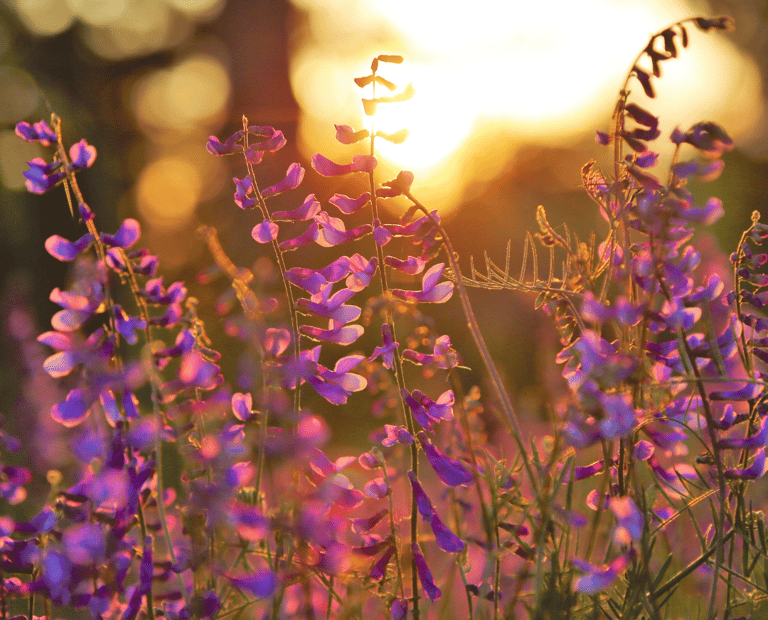Sensory Awakening in Spring – 5 Wellness Rituals to Embrace It Fully
WELLNESS
Nicole Furia
5/4/202510 min read
When I was a child, one day our teacher gave us a special assignment: to describe Spring using our five senses. Wow.
I still remember the excitement of that exercise, how each of my classmates tried to put into words the colors, the scents, the sensations of this magical season. I don’t remember exactly what I wrote back then, but if I had to answer today, I know exactly what I would say…
Spring, to me, has an unmistakable taste.
The taste of wild asparagus — definitely not for everyone, but my partner and I adore it. We often go for walks in the woods to gather some, and sometimes we’ve eaten a bit too much! But Spring also means the sweet, fresh taste of strawberries and cherries. And then, as the season unfolds, they arrive: my beloved peaches and apricots — little bites of sunshine.


Spring is light.
The days grow longer, the sun gets warmer. There’s the tender green of new leaves, the bright yellow of the first flowers. It’s hard to express it in just one color because Spring is an explosion of hues.
Spring is sound.
It’s the birdsong at dawn, the rustle of wind through delicate leaves, the buzzing of bees on flowers. It’s nature awakening — and turning into music.
Spring is something you feel on your skin.
The gentle sun, the soft breeze, the air that seems to change in texture. It’s the pleasure of sinking your hands into the soil, planting new flowers, feeling life in your fingertips.
And finally, for me, Spring smells like freshly cut grass in the gardens, like daisies and cherry blossoms that used to color my aunt’s courtyard.
It’s a scent that awakens, that brings new energy after the drowsiness of winter. A fragrance that, I believe, touches our deepest strings — the ancestral ones, from when we lived in harmony with the Earth.
And that’s exactly what fascinates me about Spring: this change.
After months of stillness and introspection, everything begins to move again — nature, our bodies, our energy. It’s a moment of transition, of deep renewal.
But like any change, it’s not always easy.
Not everyone loves Spring. Some experience it as a joyful awakening, while others feel it as a difficult adjustment phase.
Our bodies may feel more tired than usual, sleep may be disturbed by the changing light, the immune system challenged by temperature swings. And for those with allergies, blooming isn’t just an explosion of color — it’s sneezing fits and burning eyes.
And then there’s the emotional side.
Spring is movement, expansion — but for some, this dynamism can also bring restlessness or anxiety, as if body and mind struggle to synchronize with the new rhythm.
So how can we welcome this season more harmoniously, respecting our own pace and feelings?
For me, I’ve found that adding a small ritual to my daily routine makes a big difference. It helps me feel better, more grounded, more in tune with the changes around me. It doesn’t have to take long — even just 10 minutes a day can help.


When I talk about ritual, I don’t mean something complicated.
I mean a conscious pause — a moment where we stop, let go of distractions, and bring our full presence and intention to what we’re doing. A simple gesture, repeated daily, can transform our well-being.
If you don’t already have a feel-good ritual, stay with me — because today I want to share with you 5 sensory rituals that have helped me experience Spring in a more harmonious way.
Five small practices — one for each sense — to root ourselves in the present and flow with this season, instead of resisting it.
You don’t have to do all five — even just one might be just what you need, or it might inspire you the way they’ve inspired me.
And stay with me until the end, because I’d like to leave you with an extra reflection.
1st Ritual – For the Sense of Taste:
Spring is a new beginning, a time when the body awakens and releases the toxins accumulated over the winter months.
And what better way to start the day than with an ancient cleansing ritual?
Oil Pulling is a centuries-old Ayurvedic practice that involves swishing oil in the mouth to remove toxins (Ama in Sanskrit), improve oral health, and refine the sense of taste.
The English term oil pulling comes from the Sanskrit word Kavala, meaning literally “to extract with oil,” as the oil traps bacteria and toxins, which are then expelled.
Rooted in the Ayurvedic tradition, this practice helps reduce harmful oral bacteria, improve gum health, whiten teeth, and support digestion. According to Ayurveda, cleaning the mouth in the morning removes toxins that the body released overnight — promoting a feeling of lightness and overall well-being.
Why is it especially useful in Spring?
Because Spring is the body’s natural detox time — digestion shifts, energy renews, and we feel lighter. Oil pulling supports this renewal and gives a fresh start to the day.
How to do it:
Use 1 tablespoon of oil (the most common are sesame or coconut oil; I use a small jar of organic food-grade coconut oil. Since it changes consistency with the temperature, you might need 2–3 teaspoons if it’s still solid).
Swish it around your mouth, pulling it between your teeth — do not swallow it!
If you're just starting, begin with 5 minutes. Gradually increase to 10, and if you can, up to 20 minutes.
Spit out the oil and rinse your mouth with warm water.
Then brush your teeth as usual.
For how long?
Ideally, do it every morning for at least 2–3 weeks to feel the benefits. But even doing it for a few days when you feel the need for a deeper cleanse can be helpful.
There are no major contraindications, though at first it may feel strange or tiring. If your jaw gets tired, reduce the time and try to relax your face while doing it. It’s also very important not to swallow the oil — it contains the toxins we’re trying to eliminate. Of course, if you have any health concerns, consult your doctor or healthcare provider.
This simple morning ritual can become a moment of mindfulness and self-care — a gentle way to welcome Spring with freshness and vitality.
Extra tip: While doing oil pulling, put on some music you love — it will help you stay relaxed, keep you from getting bored, and start your day off on the right foot.
2nd Ritual – For the Sense of Sight:
Our eyes are among the first to feel seasonal changes: more light can cause eye fatigue, while Spring winds and allergies may lead to redness or dryness. And of course, screen time only adds to the strain.
A simple, natural way to soothe them is a warm chamomile compress — a timeless ritual with calming, decongestant properties.
Here’s how:
Heat a cup of water and steep two chamomile tea bags for a few minutes.
Once the infusion is warm (not hot), dip a small towel in the tea and wring it out slightly.
Place the towel over your closed eyes and relax for 5–10 minutes, breathing deeply.
Repeat in the evening before bed or whenever your eyes feel tired.
The compress is generally safe, but if you have very sensitive eyes or a chamomile allergy, do a small patch test first. Also, make sure the temperature feels pleasant and isn’t too hot to avoid irritation or burns.
Warmth helps relax the eye muscles and supports microcirculation. However, if your main goal is to reduce puffiness, a cold compress might work better.
Extra Tip – Palming to relax the eyes:
After the compress, you can try a palming exercise to further ease your gaze:
✔ Rub your hands together to generate warmth.
✔ Gently place your palms over your closed eyes without applying pressure.
✔ Stay like this for a few minutes, breathing deeply.
✔ Slowly open your eyes and notice how your vision feels more relaxed.
A simple gesture — but incredibly effective in soothing tired eyes and embracing Spring light with a refreshed gaze.
3rd Ritual – The Sense of Hearing:
Listening to spring means allowing its energy to flow through you. The birdsong in the morning, the rustling of the wind through the leaves, the sound of flowing water… Nature is awakening, and so are we.
A chakra meditation during this season is like tuning into the heartbeat of the Earth: it aligns us, cleanses us, and recharges us.
Chakras are energy centers located along the spine that regulate the flow of energy in the body. There are seven, each associated with a specific physical, emotional, and spiritual function. When energy flows freely through the chakras, we feel balanced and full of vitality. On the other hand, blockages or imbalances can affect our well-being.
I’d love to explain them more in-depth in a future episode… stay tuned if you're curious.
Each chakra has a specific vibration, and working with sound can help release energy blocks, improve focus, and promote a sense of inner balance.
This season represents a new beginning—a perfect time to rebalance our energies and let go of what no longer serves us. Chakra meditation, combined with sound (mantras or frequencies), can help awaken your life energy and harmonize it with the growth and movement of nature.
How to practice:
Find a quiet place and sit in a comfortable position. Close your eyes and bring your attention to your breath.
Start with the Root Chakra (Muladhara) and imagine a red energy at the base of your spine. You can repeat the sound LAM to activate it.
Slowly move up through the other chakras, visualizing their corresponding colors and repeating their specific sounds:
Sacral Chakra (Svadhisthana) – Visualize orange energy expanding in the area below your navel, in the lower abdomen. Repeat the sound VAM.
Solar Plexus Chakra (Manipura) – See a bright yellow light radiating from the center of your abdomen, just above your navel. Repeat the sound RAM.
Heart Chakra (Anahata) – Imagine green energy expanding from the center of your chest, radiating love and harmony. Repeat the sound YAM.
Throat Chakra (Vishuddha) – Visualize blue energy vibrating in your throat, supporting authentic expression and communication. Repeat the sound HAM.
Third Eye Chakra (Ajna) – Picture a deep indigo light between your eyebrows, a glowing point expanding in your mind, bringing clarity and intuition. Repeat the sound OM.
Crown Chakra (Sahasrara) – Visualize a violet or white light above the top of your head, like a lotus flower opening upward. Feel connected to the universe, letting silence or the sound AUM lead you into a state of pure awareness.
Take deep breaths between each chakra, feeling the energy flowing freely through your body.
How much time should you dedicate?
You can start with 5–10 minutes a day, focusing on a single chakra or moving through them all.
If you don’t feel comfortable with mantras, you can simply listen to the sounds of nature and let them rebalance your energy. Go outside, close your eyes, and let the birdsong, the wind, or flowing water guide you to a deeper connection with spring.
A simple yet powerful gesture to awaken body and mind to the rhythm of nature.
And if you’re not used to meditating, you can find many beautiful guided meditations online and simply relax and let yourself be guided by the flow.
4th Ritual – The Sense of Touch:
The skin is our boundary with the world, where the inside and outside meet. In spring, just as nature renews itself, our face too needs to awaken, release tension, and rediscover its natural radiance. A lymphatic massage with Rosehip oil is the perfect gesture to support this rebirth process.
After winter, the face may appear puffier or duller due to reduced circulation. Lymphatic massage helps drain excess fluids, stimulate microcirculation, and relieve accumulated muscle tension in the face. Rosehip oil, with its regenerating properties, deeply nourishes the skin, giving it elasticity and glow.
How to practice:
✔ Cleanse your skin with a gentle product and apply a few drops of Rosehip oil to your face.
✔ Open the lymphatic stations: using your fingertips, apply light pressure behind your ears and on the collarbone to activate drainage.
✔ Gentle massage: with slow, light movements, glide your fingers along your neck, cheeks, and jawline—always moving from the inside outward and from top to bottom. (Downward because we are draining toward the larger lymphatic station in the collarbones.)
✔ Repeat for 5–10 minutes, breathing deeply.
Are there any contraindications?
Lymphatic massage is a gentle technique suitable for everyone, but if you have skin inflammation, infections, or lymphatic drainage issues, it’s best to consult a professional first.
Extra Tip – A gesture to awaken the skin:
After the massage, soak a towel in warm water, wring it out, and place it gently on your face for a few seconds. The heat helps the oil absorb better and amplifies the feeling of relaxation.
Touching your face with awareness is an act of self-love—a way to connect with your skin and embrace its authentic beauty.
5th Ritual – The Sense of Smell:
Smell is the sense most closely linked to emotions and memory. With the arrival of spring, we can use aromatherapy to awaken the mind and invite a feeling of lightness and well-being.
Bergamot essential oil is like a ray of sunshine: its citrusy yet gentle scent lifts the mood, relieves tension, and brings clarity during times of change.
Why use it in spring?
Just as nature is reborn, we too feel the need to release the stagnant energy of winter. Bergamot helps rebalance emotions, infusing positivity and freshness.
How to practice:
✔ Best method: the diffuser
The best way to enjoy Bergamot’s aroma is with an ultrasonic diffuser. Simply add 5–7 drops of essential oil to the water and let it spread a bright, revitalizing atmosphere throughout your space.
✔ No diffuser? Try the steam ritual
If you don’t have a diffuser, you can still enjoy a moment of connection with this scent:
Boil some water and pour it into a heat-safe bowl.
Wait a few minutes before adding 3–5 drops of Bergamot essential oil (excessive heat can alter the oil’s properties, so the water should be warm, not hot).
Are there any contraindications?
Bergamot essential oil is generally safe, but it is photosensitizing: if applied to the skin, avoid sun exposure for at least 12 hours. Always dilute it properly and never use it undiluted. Also, some individuals and pets may be sensitive to essential oils in the air, so always start with just a few drops.
That was the final ritual—I hope you find them helpful.
Here’s my reflection:
These are small gestures—five sensory rituals—but they can support a deeper connection with nature and with ourselves. Because when we slow down and do something for our well-being, we begin to hear what our body and mind truly need.
Whether it’s the warmth of a compress over your eyes, the gentleness of a facial massage, the vibration of sound, or the fresh scent of Bergamot, each act becomes a small moment of care and presence.
And isn’t that what Spring teaches us? To awaken gently, to follow our rhythm without force—just like every plant blossoms in its own time.
There isn’t one right way to welcome this season: we can resist change or flow with it, honoring what makes us feel well. But if we choose to flow, to bloom, we may discover how rejuvenating it is to let ourselves be carried by the beauty of this rebirth.
And you—how do you feel Spring?
Thank you for listening this far.
In the next episode, we’ll talk about a topic close to my heart: how wrinkles speak about us, and we’ll explore the subtle connection between facial expressions, emotions, and well-being.
A warm hug, and remember to take time for yourself, letting Spring move through you gently with its renewing energy.
